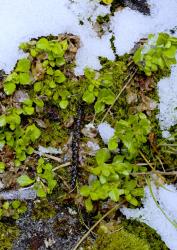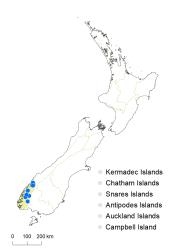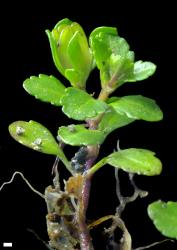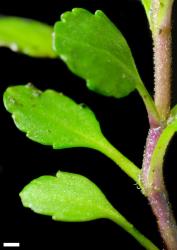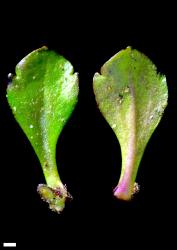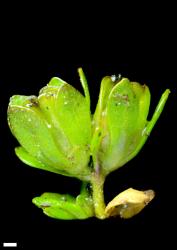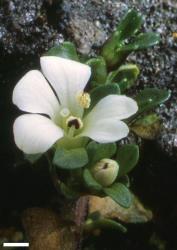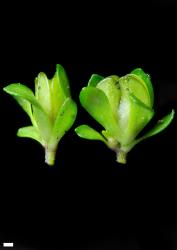- ≡ Veronica laxa G.Simpson & J.S.Thomson, Trans. & Proc. Roy. Soc. New Zealand 72: 32 (1942) nom. illeg., non Veronica laxa Benth. 1835
- ≡ Parahebe laxa W.R.B.Oliv., Rec. Domin. Mus. 1: 230 (1944) nom. nov. pro Veronica laxa G.Simpson & J.S.Thomson 1942
- ≡ Parahebe planopetiolata var. laxa (W.R.B.Oliv.) Ashwin in Allan, Fl. New Zealand 1, 882 (1961)
Lax and soft-straggling sub-shrub to 0.15 m tall. Stems decumbent or ascending, eglandular-pubescent, or rarely with some glandular hairs as well; hairs uniform. Leaf bud indistinct; leaves separating while very small, opposite-decussate, erecto-patent to spreading; lamina sub-coriaceous, elliptic to orbicular or spathulate, 3–10 mm long, 2–9 mm wide, glossy green or dark green above, dull pale green beneath; veins not evident or midrib faint; surfaces glabrous; margin glabrous, crenate or bluntly serrate, rarely entire; teeth in 0–5 pairs; apex rounded to truncate; base cuneate; petiole 3–5 mm long. Inflorescence a lateral raceme, 8–15 mm long; flowers distant, usually 2–3 or sometimes solitary and bibracteate, all bisexual; bracts alternate, oblanceolate or spathulate, > pedicels; pedicels erecto-patent, 1–3 mm long, eglandular-hairy all around. Calyx lobes 4, obtuse to sub-acute, 4–8 mm long, glabrous. Corolla 5–6 mm diameter; tube white and yellowish, 1.5–3.0 mm long, < calyx, glabrous; lobes 4–5, white, sub-erect to spreading, sub-equal, oblong to obovate, 3–6 mm long, obtuse or rounded; nectar guides absent. Stamen filaments white, 0.5–2.0 mm long; anthers purple. Style glabrous, 0.5–3.0 mm long. Capsules angustiseptate, didymous, glabrous, 4–6 mm long, 3.5–5.5 mm at widest point. Seeds ellipsoid, flattened, smooth, pale brown, 1.0–1.3 mm long.
V. zygantha and V. planopetiolata plants are similar, and both are classified in the snow hebe group. V. planopetiolata plants can be distinguished by their more compact, mat-forming habit, narrower leaves, and spreading (rather than antrorse) stem and inflorescence hairs.
V. lyallii plants may be superficially similar to V. zygantha plants in their small, rounded leaves, but these are thicker and dull or bronze-green. V. lyallii plants are more woody and they have long inflorescences of many short-tubed flowers, folded lateral corolla lobes, and only weakly flattened capsules.
South Island: Fiordland (Freeman Burn, Fowler Pass, Doon River, Wapiti Lake, Mt Tūtoko, Homer Valley, Mt George, Mt Burns).
Fine, sandy debris among boulders on screes and moraines, often on east-facing boulder screes below cliffs. Recorded elevations range from 920 to 1650 m.
Flowers: February–March; fruits: March–April.
2n = 84 (Beuzenberg & Hair 1983, as Parahebe laxa).
Veronica zygantha is classified in V. subg. Pseudoveronica sect. Hebe but is not currently assigned to any informal group (Albach & Meudt 2010). The phylogenetic position of V. zygantha is uncertain, because it has not been included in published molecular studies so far. On morphology it seems likely to be placed close to the speedwell hebes, especially V. colostylis and V. planopetiolata, or to the snow hebes, such as V. birleyi and V. spectabilis.
Based on limited herbarium collections, V. zygantha plants in the northern part of its range (e.g., at Freeman Burn and Fowler Pass) may have broader calyx lobes, smaller corollas, shorter styles (0.5–0.8 mm long), and anthers that touch the stigma at anthesis.



